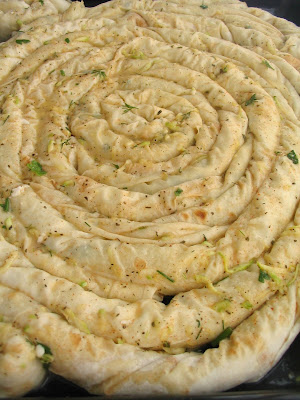 Börek
Börek is a common name in Turkey and neighboring regions that were influenced by Ottoman cuisine for a pie made with flaky pastry: phyllo or
yufka. Börek can be made in different forms (
bundles,
rolls, rounds, squares, etc.) and with different fillings (eggplant, ground meat, milk, potato, spinach, and white cheese).
This particular recipe is my mom's signature dish. This is the dish that I asked her to make every time I went back home from boarding school, college or from the States, and that my friends ask her to make whenever they come over for tea, for dinner, or for a visit. I haven't made zucchini börek before simply because it is hard to find Turkish
yufka here and phyllo doughs that you can find in the stores are too thin (harder to deal with), starchier (fit better for baklava than börek
), and come in rectangles rather than rounds as we have them in Turkey. However, for the first time I haven't been to Turkey over a year now. I decided that I couldn't wait for another year for zucchini börek.

~30 sheets of phyllo dough=1 box (since they're really thin, a couple will be lost along the way)
for the filling2-3 zucchinis, grated approximately 4 cups of grated zucchini
3 eggs
1/2 cup finely chopped dill
1/3 cup finely chopped fresh mint or 3 tbsp dry mint flakes
1/2 cup crumbled Turkish white cheese or feta
1 tbsp paprika (or Hungarian paprika)
1 tbsp or less black pepper
salt (depending on how salty the cheese is)
1 tsp spicy red pepper flakes (optional)
for brushing phyllos3 tbsp olive oil
1/2 cup plain yogurt (nonfat, reduced, or whole)
-Thaw frozen phyllo as indicated on the package.
-Mix well all the ingredients for the filling in a bowl. Set aside for 10-15 minutes.
-It will be a juicy mixture. Squeeze the mixture and pour that excessive juice into a smaller bowl. Add 3 tbsp olive oil and 1/2 cup yogurt into the juice and mix well. You will use this to brush phyllos.
-Place a phyllo, wide side facing you, on the counter. Brush it with the mixture and put another phyllo on top and brush it, too. Since phyllos are too thin, it's better to use two at a time).
-Place filling ~one seventh of zucchini filling on the long side of phyllo and roll up to make a long cigar.
-Grease ~ 11 X 13 or ~11 X 11 oven tray.
-Hold one end of the long cigar and coil roll around to form a spiral shape as in the picture above.
-Repeat brushing, filling, rolling, and coiling until there's no more filling.
-Pour whatever juice left in the brushing and filling bowls on the börek.
-Bake in a preheated oven at 380-390 F until golden brown. Approximately 50 minutes.
-Cut into triangle pie slices. Serve with tea or soda for breakfast, lunch, or dinner.
It is not a common practice throughout Turkey, but where I come from, Thrace, we love to eat our savory börek by dipping it into jam, especially into cherry jam.






























































